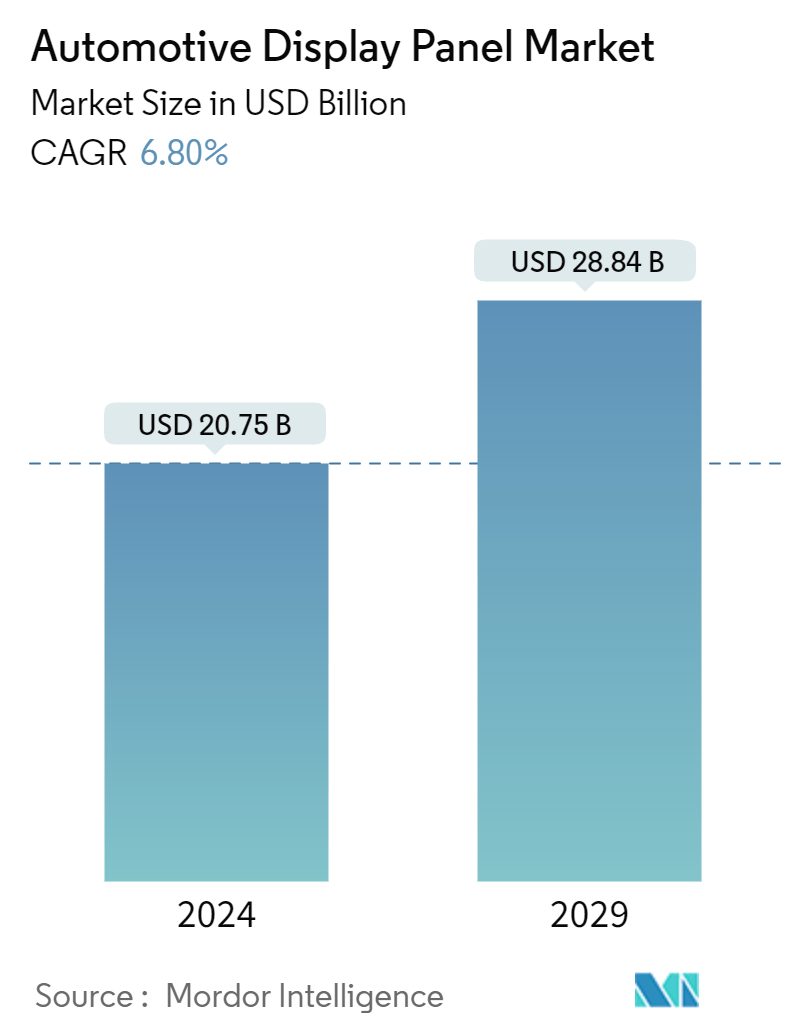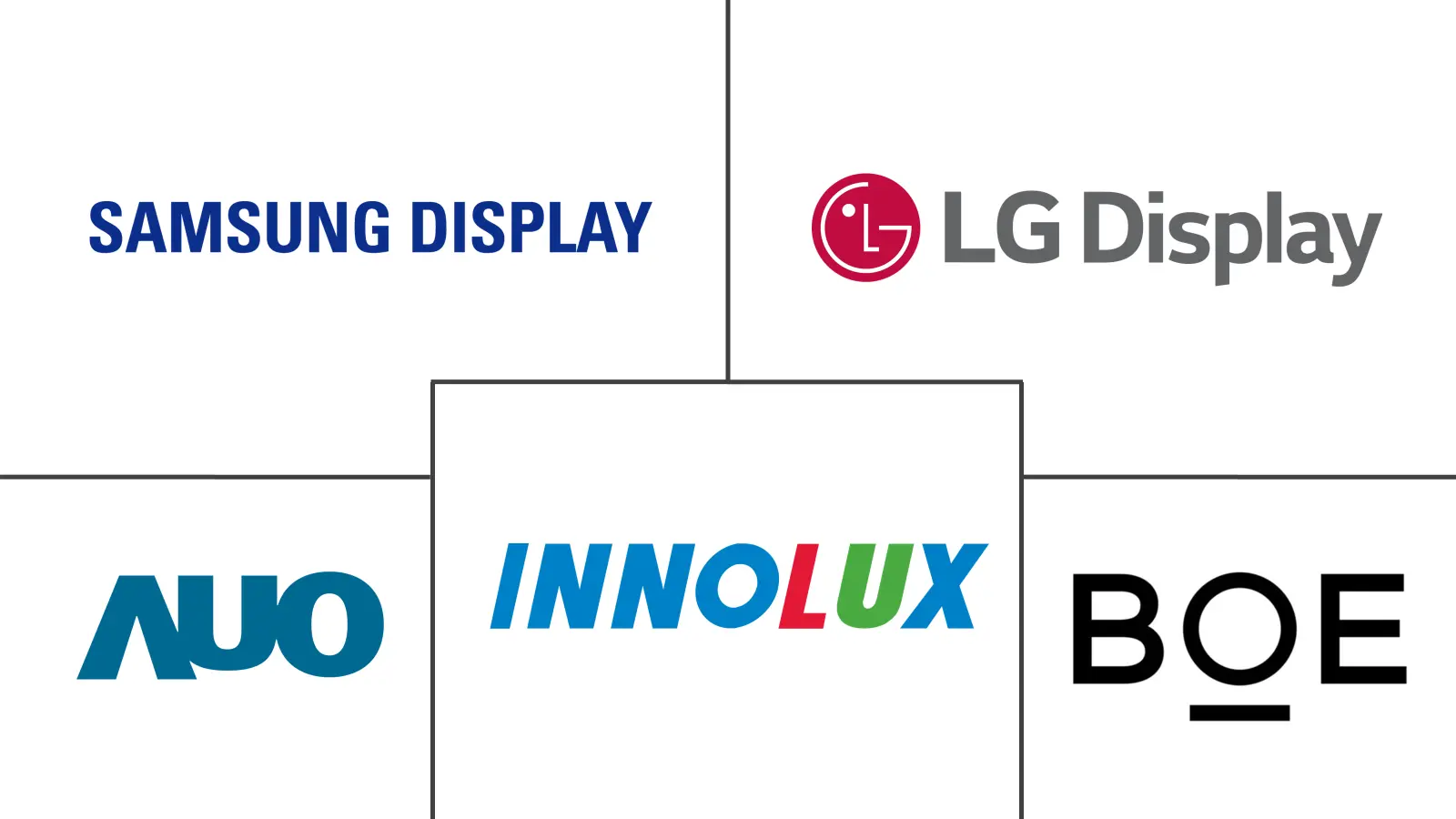Market Size of Automotive Display Panel Industry

| Study Period | 2019 - 2029 |
| Market Size (2024) | USD 20.75 Billion |
| Market Size (2029) | USD 28.84 Billion |
| CAGR (2024 - 2029) | 6.80 % |
| Fastest Growing Market | Asia Pacific |
| Largest Market | North America |
| Market Concentration | Low |
Major Players
*Disclaimer: Major Players sorted in no particular order |
Automotive Display Panel Market Analysis
The Automotive Display Panel Market size is estimated at USD 20.75 billion in 2024, and is expected to reach USD 28.84 billion by 2029, growing at a CAGR of 6.80% during the forecast period (2024-2029).
- The automotive display panel market is witnessing robust growth due to increased demand for semi-autonomous and autonomous vehicles, improved consumer experience in vehicles, and high growth in luxury and high-end car segments, mainly in emerging markets. Consumers increasingly expect sophisticated vehicle infotainment systems, including touchscreens, navigation systems, and connectivity features.
- Automotive display panels serve multiple vehicle functions, providing information such as speed, fuel levels, navigation directions, and entertainment options. They also contribute to safety by displaying warnings and alerts for issues like low tire pressure or engine malfunctions. Additionally, they offer settings for various features like climate control and audio systems.
- Before microLED technology becomes mature for commercial use, miniLED-backlit LCD panels compete with OLED panels for application to high-end automotive displays. Market vendors are also innovating their offerings to provide solutions across various vehicles. For instance, LD Display announced plans to develop hybrid OLED panels for lower-cost cars.
- Hybrid OLED panels combine the strengths of OLED (organic light-emitting diode) and LCD (liquid crystal display) technology. OLED displays offer impressive visual quality with deep blacks, vivid colors, and excellent contrast. However, the manufacturing costs of OLED panels are traditionally higher than those of LCD panels. By integrating LCD elements into their hybrid OLED panels, LG Display aims to deliver superior visual performance while reducing production costs.
- Stricter safety regulations push automakers to include more advanced driver assistance systems (ADAS) in vehicles, often requiring display panels to convey critical information to drivers. In February 2024, UNECE’s Working Party on Automated/Autonomous and Connected Vehicles adopted the draft of a new regulation that states provisions for the approval of vehicles with driver control assistance systems and provides minimum safety requirements for vehicles equipped with the advanced driver assistance system, such as lane keep assist.
- Similarly, the Indian government has been stressing enhanced car safety for years. After the mandatory six airbags rule, slated to be implemented in October 2024, the government contemplates making certain ADAS features mandatory on Indian cars. As per a recent report published in PTI, the Ministry of Road Transport and Highways (MoRTH) has drafted a new proposal to reduce road accidents in India. Such trends are expected to drive the market growth during the forecast period.
- Advanced display technologies can be expensive to implement, which may increase the overall cost of vehicles. This could deter price-sensitive consumers or manufacturers looking to keep production costs low. Also, integrating display panels into vehicles adds complexity to the manufacturing process and may require additional training for maintenance and repair technicians.
- Also, the ongoing Russia-Ukraine war has significantly impacted various industries, including the automotive sector. The disruption caused by the war has affected the growth of the automotive display panel market in several ways. The war has also caused shortages of raw materials in the automotive industry. Ukraine and Russia are major producers of commodities like aluminum and rare gases, essential for automotive manufacturing. The disruption in the supply of these raw materials has further affected the production of automotive display panels.
Automotive Display Panel Industry Segmentation
Automotive display panels are electronic screens used in vehicles to provide visual information to drivers and passengers. These panels can be found in various vehicle locations, such as the instrument cluster, center console, dashboard, rear mirror, and steering wheel. They are designed to display a wide range of information, including vehicle speed, fuel level, engine temperature, navigation directions, and entertainment system controls.
The automotive display panel market is segmented by display panel (technology [a-Si LCD, Oxide LCD, LTPS LCD, and AMOLED]), display console/cluster (application [instrument cluster, center stack, heads-up display, and other applications]), and geography (North America, Europe, Asia-Pacific, Middle East and Africa, and Latin America). The market sizes and forecasts are provided in terms of value in USD for all the above segments.
| Display Panel | ||||||
|
| Display Console/Cluster | ||||||
|
| By Geography*** | |
| North America | |
| Europe | |
| Asia | |
| Australia and New Zealand | |
| Middle East and Africa | |
| Latin America |
Automotive Display Panel Market Size Summary
The automotive display panel market is experiencing significant expansion, driven by the rising demand for semi-autonomous and autonomous vehicles, enhanced consumer experiences, and the burgeoning luxury car segment, particularly in emerging markets. Consumers are increasingly seeking advanced vehicle infotainment systems, which include touchscreens, navigation, and connectivity features. These display panels are integral to vehicle functionality, providing essential information such as speed, fuel levels, and navigation directions, while also enhancing safety by displaying critical warnings and alerts. The market is witnessing technological advancements, with innovations like hybrid OLED panels aimed at balancing superior visual quality with cost-effectiveness. Stricter safety regulations are further propelling the market, as they necessitate the inclusion of advanced driver assistance systems (ADAS) that require sophisticated display panels.
North America is poised to hold a substantial share of the automotive display panel market, supported by its robust automotive industry and the adoption of mass production techniques. The region's market is bolstered by major automotive companies and government initiatives to implement ADAS features, which are expected to drive demand for advanced display panels. The competitive landscape is fragmented, with numerous players investing in technological developments and product innovations to capture market share. Companies like LG Display and Continental AG are showcasing cutting-edge display solutions, including ultra-large and microLED technology displays, which are set to redefine in-vehicle experiences. The ongoing geopolitical tensions, such as the Russia-Ukraine war, have impacted the supply chain, affecting the availability of essential raw materials for display panel production, thereby influencing market dynamics.
Automotive Display Panel Market Size - Table of Contents
-
1. MARKET INSIGHTS
-
1.1 Market Overview
-
1.2 Technological Trends
-
1.3 Industry Supply Chain Analysis
-
1.4 Industry Attractiveness - Porter's Five Forces Analysis
-
1.4.1 Threat of New Entrants
-
1.4.2 Bargaining Power of Buyers/Consumers
-
1.4.3 Bargaining Power of Suppliers
-
1.4.4 Threat of Substitute Products
-
1.4.5 Intensity of Competitive Rivalry
-
-
1.5 Impact of COVID-19 Aftereffects and Other Macroeconomic Factors on the Market
-
-
2. MARKET SEGMENTATION
-
2.1 Display Panel
-
2.1.1 By Technology
-
2.1.1.1 a-Si LCD
-
2.1.1.2 Oxide LCD
-
2.1.1.3 LTPS LCD
-
2.1.1.4 AMOLED
-
-
-
2.2 Display Console/Cluster
-
2.2.1 By Application
-
2.2.1.1 Instrument Cluster
-
2.2.1.2 Center Stack
-
2.2.1.3 Heads-up Display
-
2.2.1.4 Other Applications
-
-
-
2.3 By Geography***
-
2.3.1 North America
-
2.3.2 Europe
-
2.3.3 Asia
-
2.3.4 Australia and New Zealand
-
2.3.5 Middle East and Africa
-
2.3.6 Latin America
-
-
Automotive Display Panel Market Size FAQs
How big is the Automotive Display Panel Market?
The Automotive Display Panel Market size is expected to reach USD 20.75 billion in 2024 and grow at a CAGR of 6.80% to reach USD 28.84 billion by 2029.
What is the current Automotive Display Panel Market size?
In 2024, the Automotive Display Panel Market size is expected to reach USD 20.75 billion.

